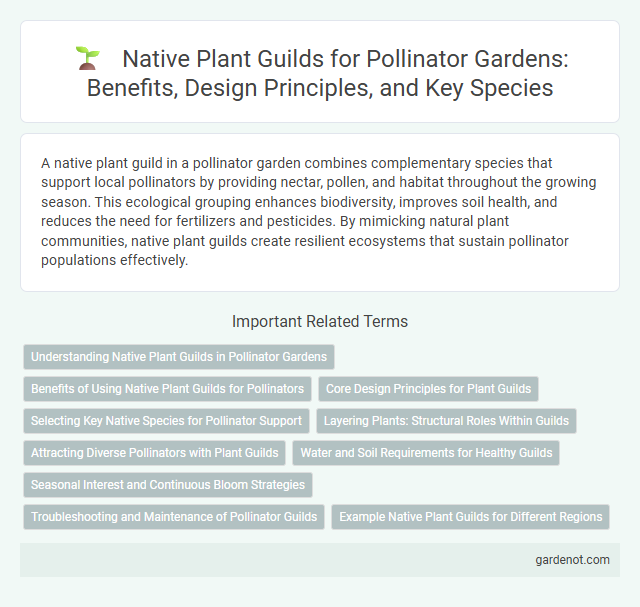A native plant guild in a pollinator garden combines complementary species that support local pollinators by providing nectar, pollen, and habitat throughout the growing season. This ecological grouping enhances biodiversity, improves soil health, and reduces the need for fertilizers and pesticides. By mimicking natural plant communities, native plant guilds create resilient ecosystems that sustain pollinator populations effectively.
Understanding Native Plant Guilds in Pollinator Gardens
Native plant guilds in pollinator gardens create synergistic ecosystems by combining complementary species that support pollinators through diverse foraging and nesting resources. Understanding the roles of nitrogen-fixing plants, flowering perennials, and ground covers helps establish balanced habitats promoting pollinator health and biodiversity. Incorporating native plant guilds enhances resilience against pests and environmental stress while providing continuous blooms that sustain pollinators throughout the growing season.
Benefits of Using Native Plant Guilds for Pollinators
Native plant guilds create a diverse habitat that supports a wide range of pollinators by providing continuous blooms and essential resources like nectar, pollen, and shelter. These guilds enhance ecosystem resilience, improve soil health through mutually beneficial plant relationships, and reduce the need for chemical interventions. Pollinators thrive in native plant guilds due to the availability of plants adapted to local climate and soil conditions, promoting sustainable biodiversity and stronger pollination networks.
Core Design Principles for Plant Guilds
Native plant guilds create resilient pollinator gardens by combining various species that fulfill complementary ecological functions. Core design principles emphasize incorporating nitrogen-fixing plants, dynamic accumulators, and pollinator-attracting flowering species to enhance soil health, nutrient cycling, and habitat diversity. Structuring guilds with layered vegetation supports pollinator activity throughout seasons, promoting sustainable ecosystem services.
Selecting Key Native Species for Pollinator Support
Selecting key native species for a pollinator garden enhances biodiversity and supports local ecosystems by providing essential nectar and pollen sources. Incorporating native plants like milkweed, coneflowers, and goldenrod ensures habitat suitability for pollinators such as bees, butterflies, and hummingbirds. Emphasizing species adapted to regional soil and climate conditions promotes sustainable growth and maximizes pollinator attraction throughout the growing season.
Layering Plants: Structural Roles Within Guilds
Native plant guilds in pollinator gardens rely on layering plants to enhance structural diversity, creating microhabitats that support varied pollinator species. Canopy trees provide shade and nesting sites, while understory shrubs offer nectar sources and protective cover. Ground layer herbs and flowering plants supply essential forage, promoting a resilient ecosystem and fostering pollinator health through diverse resource availability.
Attracting Diverse Pollinators with Plant Guilds
Native plant guilds maximize biodiversity by combining complementary species that support diverse pollinators like bees, butterflies, and hummingbirds. These guilds include nectar-rich flowers, host plants for larvae, and shelter-providing shrubs, creating a self-sustaining ecosystem that enhances pollinator attraction and conservation. Strategic planting of native guilds promotes healthier pollinator populations essential for ecosystem resilience and crop pollination.
Water and Soil Requirements for Healthy Guilds
Native plant guilds in pollinator gardens thrive when water and soil requirements are carefully balanced to support diverse species. Well-drained, nutrient-rich soils combined with moderate, consistent watering foster deep root development and resilient plant health. Selecting native plants adapted to local moisture levels reduces irrigation needs and promotes sustainable habitat for pollinators.
Seasonal Interest and Continuous Bloom Strategies
Native plant guilds in pollinator gardens employ seasonal interest and continuous bloom strategies by selecting a diverse array of regional flora that flower at staggered intervals throughout the growing season. This approach ensures a persistent supply of nectar and pollen for pollinators such as bees, butterflies, and hummingbirds from early spring to late fall. Integrating canopy, understory, and groundcover species maximizes habitat complexity and supports biodiversity by providing shelter and feeding resources year-round.
Troubleshooting and Maintenance of Pollinator Guilds
Effective troubleshooting of native plant guilds in pollinator gardens involves regularly monitoring for common pests such as aphids and caterpillars, and implementing organic pest control methods like neem oil or insecticidal soap. Maintenance requires periodic pruning of overgrown vegetation to ensure proper airflow and sunlight penetration, which supports healthy pollinator activity. Soil health should be assessed seasonally, with the addition of organic compost to maintain nutrient balance and promote robust plant growth within the guild.
Example Native Plant Guilds for Different Regions
Native plant guilds combine compatible species that support pollinators and enhance biodiversity by mimicking natural ecosystems. Examples include the Pacific Northwest guild featuring Oregon grape, red-flowering currant, and snowberry, while the Southeast United States boasts a mix of milkweed, goldenrod, and purple coneflower. These regional guilds provide essential nectar and habitat, improving local pollinator health and ecosystem resilience.
Native plant guild Infographic

 gardenot.com
gardenot.com